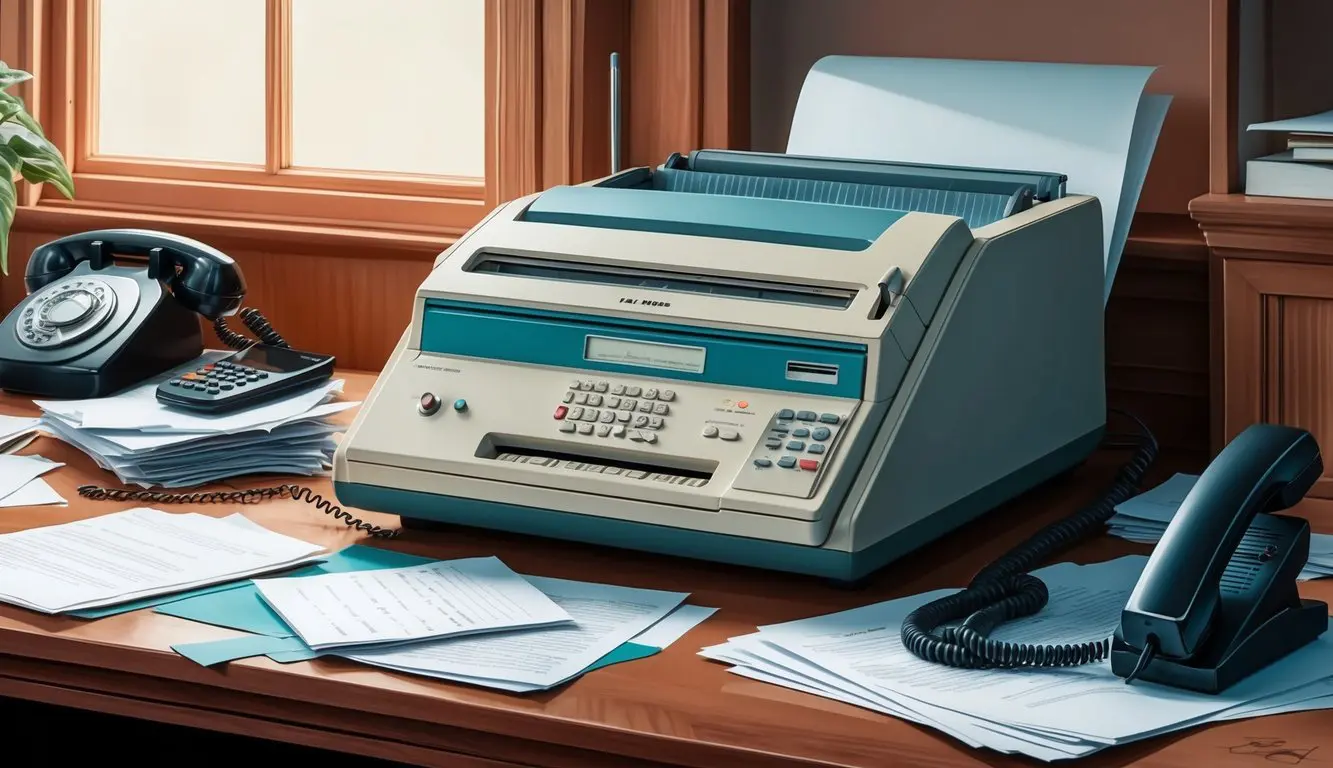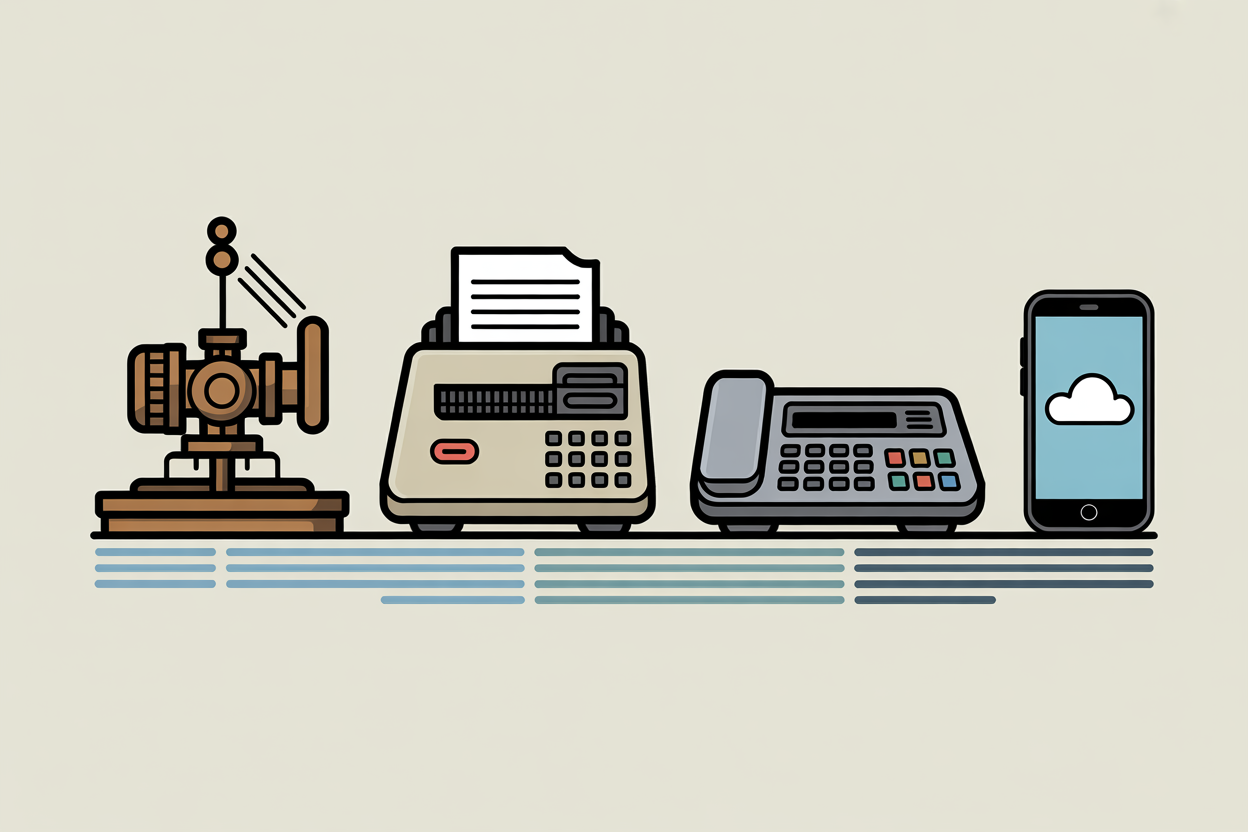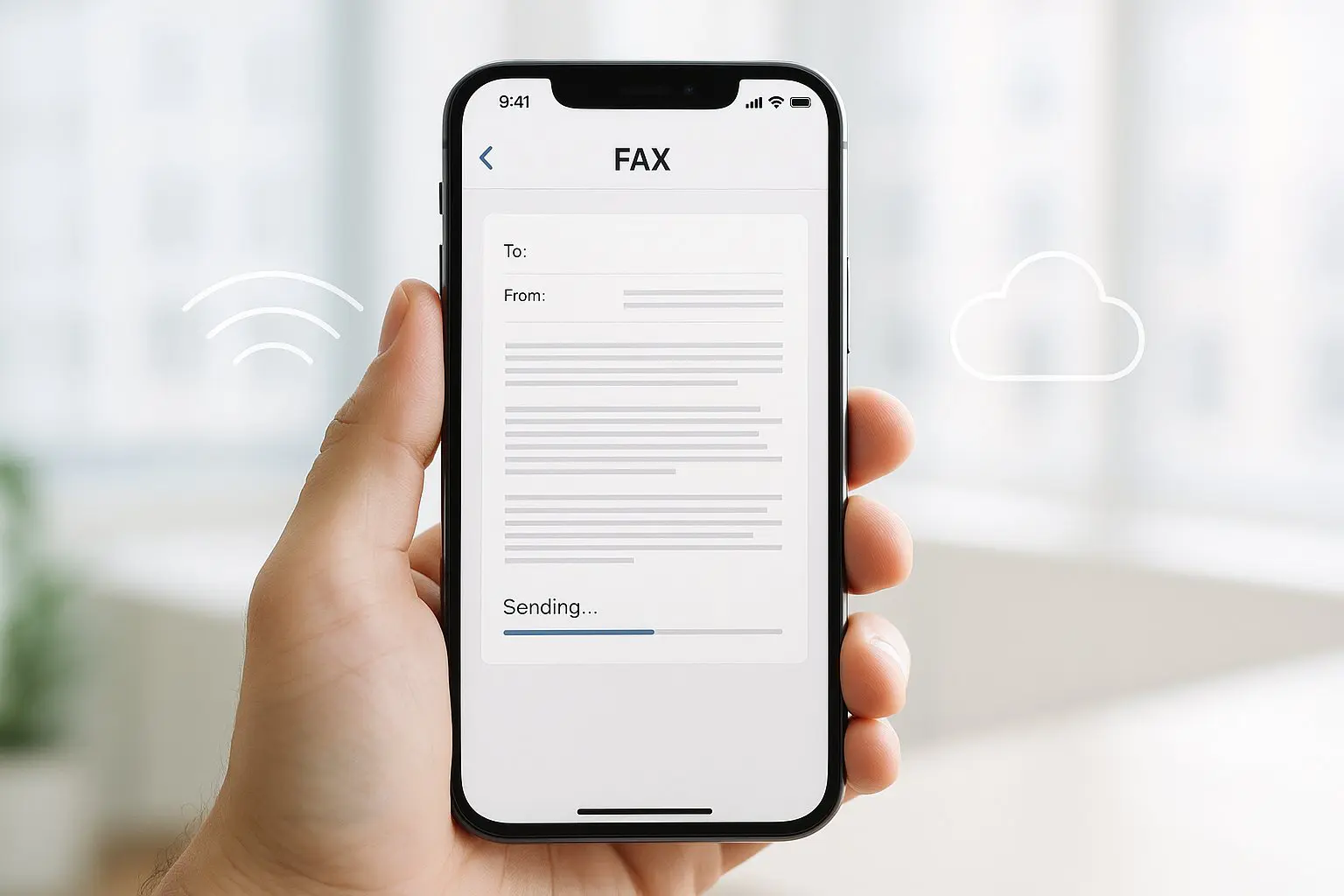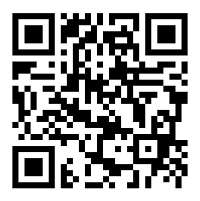Facsimile machine technology has been around for decades, but many people still wonder what it’s all about. At its core, a fax is a way to send documents over phone lines. Fax machines scan printed materials and transmit them to other fax devices, which then print out copies. It’s like sending a photo of a document, but with special equipment.
You might think faxing is outdated, but it’s still used in many industries. Doctors’ offices, legal firms, and government agencies often rely on faxes for secure document sharing. Why? Because faxes are seen as more secure and official than emails in some cases.
But faxing has changed with the times. Now, you can send faxes without a bulky machine. Online faxing services let you send and receive faxes from your computer or phone. It’s faster, cheaper, and more convenient than traditional faxing. Municorn Fax offers this modern take on an old technology, making it easy to fax from anywhere.
Historical Evolution of the Fax
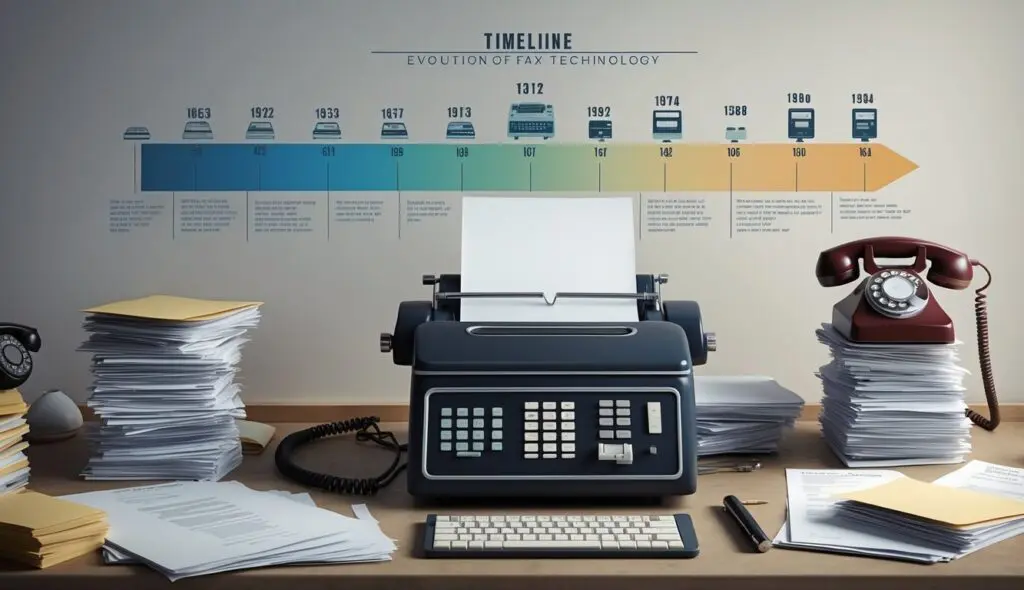
Facsimile machines have come a long way since their early days. It’s changed how we send documents, shaping business communication for over a century.
Invention and Early Developments
The fax machine’s story begins in 1843 with Alexander Bain’s “Electric Printing Telegraph”. Bain’s invention could send images over wires, laying the groundwork for the facsimile machine and modern faxing.
In the following decades, inventors improved on Bain’s idea. They made machines that could send more detailed images faster. By the early 1900s, newspapers were using fax-like devices to send photos.
These early fax machines were big and slow. They often took hours to send a single page. But they showed the potential of fax technology.
Rise of the Magnafax Telecopier
The 1960s saw a big leap in fax technology with the introduction of the Magnafax Telecopier, a revolutionary fax machine model. Xerox introduced the Magnafax Telecopier in 1966. This machine was a game-changer.
The Magnafax could send a letter-sized document in about six minutes. That was super fast for its time. It was also smaller and easier to use than older fax machines.
Businesses loved the Magnafax. It made sending documents quick and easy. Soon, fax machines became common in offices around the world.
Transition to Digital Faxing
In the 1980s, fax technology took another big step forward. New machines could send a page in seconds, not minutes. They used digital technology to improve speed and quality.
Laser technology made faxes clearer and sharper. Group 3 fax machines became the new standard. They could work with other fax machines around the world.
Today, we have online fax services like Municorn Fax. These let you send faxes from your computer or phone. It’s faxing for the digital age – fast, easy, and paper-free.
How Fax Works
Fax machines use clever technology to send documents over phone lines. They scan images, convert them to signals, and transmit data between devices. The receiving fax machine decodes the signals and prints the document.
Core Technology
Fax machines work by scanning documents line by line. They use a special sensor called a CCD (charged-coupled device) to read the image. This sensor only scans in black and white, keeping things simple.
The machine then turns the scanned image into digital data. This data represents the dark and light areas of the document. It’s like creating a map of where the ink is on the page.
Once the document is scanned, the fax machine is ready to send it. But first, it needs to connect to another fax machine. The receiving fax machine converts these signals back into an image.
Telephonic Transmission
Fax machines use regular telephone lines to send documents. When you enter a fax number, you’re actually dialing a phone number. The sending machine calls the receiving machine.
Once connected, the machines exchange special tones. These tones tell each other they’re ready to send and receive a fax. It’s like a secret handshake between fax machines.
The sending machine then converts the digital data into audio tones. These tones travel over the telephone line just like a voice call would. The receiving machine listens for these tones and decodes them back into an image.
Fax Modem and Signal Processing
The fax modem is the brain of the operation, converting digital data into audio signals that travel over telephone lines. It’s a special device that turns digital data into audio signals and back again. Modern fax machines use advanced modems to send data faster.
The modem uses clever tricks to pack more data into the signal. It can adjust the tone and timing of the audio to send information more efficiently. This is why newer fax machines are faster than old ones.
Signal processing helps clean up the fax during transmission. It can reduce noise and correct errors. This ensures the received fax looks as close to the original as possible.
Types of Fax Machines and Services
Fax technology has evolved over time, offering various options for sending and receiving documents. These range from traditional machines to modern digital solutions.
Traditional Fax Machines
Traditional fax machines have been around for decades. They scan physical documents and send them over phone lines. These machines come in different types:
- Thermal fax machines use heat-sensitive paper. They’re cheap but the prints fade over time.
- Inkjet fax machines work like regular inkjet printers. They offer color printing but can be costly to maintain.
- Laser fax machines provide high-quality prints. They’re fast and efficient for high-volume faxing.
Traditional fax machines need a dedicated phone line. They’re still used in many offices, especially for sending legal documents, but the modern fax machine offers more advanced features.
Online Fax Services
Online fax services have become popular in recent years. They let users send and receive faxes without a physical machine. Here’s how they work:
- Users upload documents to a website or app.
- The service converts the document to a fax format.
- It sends the fax over digital networks.
Online fax services like Municorn Fax don’t need special hardware. You can fax using just a computer or smartphone. They’re great for mobile workers and small businesses.
These services often offer features like:
- Cloud storage for faxed documents
- Integration with email
- Electronic signatures
Integrated Fax Systems
Integrated fax systems combine fax capabilities with other office equipment. They’re perfect for businesses that need multiple functions in one device.
Common types include:
- All-in-one printers with fax functions
- Multifunction devices that can print, scan, copy, and fax
- Computer fax servers for large organizations
These systems can send faxes directly from computers. They often use plain paper for better quality and easier filing.
Integrated systems save space and money. They’re ideal for offices that still need fax capabilities but don’t want separate machines.
Why is Faxing Still a Thing?
In the healthcare industry, faxing is the most popular method used by providers. In fact, up to 70% of healthcare professionals still use faxing, even with modern software alternatives available. This is because the Health Insurance Portability and Accountability Act (HIPAA) requires that patient information be kept secure, and faxing is a reliable way to send medical records, prescriptions and insurance claims without compromising patient privacy.
The real estate industry is the same. In this industry, transactions often involve a number of documents that need to be signed – contracts, lease agreements, property listings, and more. Faxing is a quick and legally binding way to send these documents, especially when there are time-sensitive offers or contracts involved.
Government agencies and law firms continue to use fax machines to send official documents and communicate with other parties. Many courts still accept, and in some cases, require faxed documents for the filing of legal documents. Lawyers like faxing because it provides a clear record of when a document was sent and received, which is important for meeting deadlines and proving timely submission.
The finance and banking industry is also a place where faxing is still commonly used. Banks often require faxed copies of identification documents, loan applications, and other financial information. This is partly due to regulatory requirements and the need for secure document transmission.
International trade and logistics companies also still use fax machines. Shipping documents, customs forms, and international contracts are often faxed, especially in areas where digital infrastructure is not well developed or faxing is still the preferred method of communication.
While traditional fax machines are still in use, many businesses have also started to use digital faxing solutions. These solutions allow users to send and receive faxes via email or software, combining the familiarity and legal acceptance of faxing with the convenience of digital technology.
The continued use of faxing in these industries is due to a number of factors. Regulatory requirements often mandate the use of fax for secure document transmission. Faxing is also considered a more secure method of communication than email, which is vulnerable to hacking and interception. Faxed signatures are also widely accepted as legally binding, which is important in many business and legal situations.
Culturally, faxing is also still preferred in some countries. For example, the vast majority of businesses in Japan still use faxes, and those looking to do business with them would do well to follow suit.
Looking to the future, while faxing may decline in some industries, it seems unlikely to disappear completely in the near future. According to ReportLinker, the fax services market is reported to grow 11% per year between 2022 and 2027. As long as there are industries that value security, legal recognition, and familiarity, faxing will continue to be a part of the business world.
Sending and Receiving Faxes
There are several methods to send and receive faxes, from traditional machines to modern digital options.
Using a Fax Machine
Fax machines have been around for decades. They work by scanning a document and sending it over phone lines. To use one:
- Put the document in the feeder
- Dial the recipient’s fax number
- Press the “Send” button
For a full-on guide on how to use a fax machine, refer to our guide. The machine scans the paper and transmits it. On the other end, another fax machine prints out a copy.
Fax machines are simple to use. But they have downsides. They need paper, ink, and a phone line. They can be slow and the quality isn’t always great.
For receiving faxes, the process is even easier. The machine answers incoming calls and prints faxes automatically. Just make sure it has enough paper and ink.
Online Faxing Methods
Online faxing is a modern take on faxing. It lets you send faxes without a physical machine. Here’s how it works:
- Sign up for an online fax service
- Upload your document
- Enter the recipient’s fax number
- Click “Send”
The service converts your file and sends it to the recipient’s fax machine. It’s quick and easy.
Receiving faxes online is just as simple. The service gives you a fax number. When someone sends a fax to that number, you get it as an email attachment.
Online faxing is flexible. You can send and receive faxes from anywhere with internet. It’s often cheaper than a fax machine too.
Faxing with Mobile Apps
Fax apps bring faxing to your smartphone. They’re perfect for sending faxes on the go. Here’s the basic process:
- Download a fax app
- Take a picture or a scan of your document
- Enter the fax number
- Tap “Send”
The app converts your photo or scan into a fax format and sends it off. It’s that straightforward.
For incoming faxes, the app works like other online faxing services. It provides you with a dedicated fax number to receive faxes. When someone sends a fax to this number, it appears in your app as a PDF, making it easy to view and manage your incoming faxes.
Fax Apps offer several useful features. You can combine multiple documents into a single fax and preview any document before sending. This flexibility makes it suitable for both occasional faxing and more frequent use.
The Fax Number
Fax numbers are crucial for sending and receiving faxes. They work like phone numbers but are specifically for fax machines or online fax services. Let’s explore how to get one and the different types available.
Obtaining a Fax Number
Getting a fax number is easy these days. You can get a fax number from phone companies or online fax services. Traditional fax machines use regular phone lines. But now, many people use online fax services. These services give you a virtual fax number.
To get a fax number, you can:
- Contact your phone company
- Sign up for an online fax service
- Use a VoIP provider
Toll-Free and Local Numbers
Fax numbers come in two main types: local and toll-free. Local fax numbers have a specific area code. They’re good for businesses serving a certain region. Toll-free fax numbers start with 800, 888, or similar prefixes. They’re free for the sender to use.
Local fax number example: (202) 555-1234 Toll-free fax number example: 1-800-123-4567
Toll-free numbers are great for customer service. They make it easy for people to send faxes without worrying about long-distance charges. Local numbers, on the other hand, can help a business seem more established in a specific area.
Secure Communication via Fax
Fax technology offers robust security features for transmitting sensitive documents. It provides confidentiality and uses encryption to protect information during transmission.
Confidentiality in Faxing
Faxing offers a high level of confidentiality for document transmission. Unlike email, faxes use point-to-point fixed connections, making them less vulnerable to interception. This direct communication reduces the risk of unauthorized access to sensitive information.
Fax machines typically require physical access to receive documents. This adds an extra layer of security, as only authorized personnel can retrieve the faxed materials. Many businesses still prefer fax for sending confidential documents like contracts or medical records.
Some fax services offer features like password protection for enhanced privacy. This ensures that only the intended recipient can view the faxed document.
Encryption and Security Measures
Modern fax technology employs strong encryption methods to safeguard data. Many online fax services use 256-bit SSL encryption, a robust security standard. This encryption scrambles the fax content, making it unreadable to anyone who might intercept the transmission.
Some fax systems process communications multiple times with a 256-bit key. This thorough encryption ensures that the fax remains secure throughout its journey. Only the intended recipient with the correct decryption key can access the document.
For industries handling sensitive data, such as healthcare, fax security is crucial. HIPAA regulations require secure faxing processes for medical records. Many fax services offer HIPAA-compliant options to meet these strict security standards.
Advantages of Online Fax Services
Online fax services offer many benefits over traditional faxing. They save money, work with email, and let you fax from your phone.
Cost-Effectiveness and No Hardware
Online faxing cuts costs in big ways. You don’t need to buy a fax machine or pay for paper and ink. There’s no phone line to set up either. Many online fax services have low monthly fees. Some even offer free plans for light use.
Some of the popular services let you send a few faxes for free each day, Fax App for example lets you send a free test fax. For busier offices, paid plans often cost less than old fax machines. They also save space – no bulky hardware needed. Just use your computer or phone to fax.
Integration with Email and Cloud Storage
Faxing online works great with email and cloud storage. You can send and get faxes right from your inbox. No need to wait by a fax machine. Many fax apps connect to cloud storage too.
This means you can fax files from Dropbox or Google Drive with a click. It’s easy to keep track of faxes – they’re stored digitally. You can search for old faxes fast. No more digging through paper files. Some services like RingCentral even work with office tools like Microsoft 365.
Mobile Faxing Capabilities
Faxing from your phone is a game-changer. Most online fax companies have mobile apps. You can send faxes from anywhere with internet, so no need to run back to the office.
Services like Fax App make it simple. Just snap a photo or use the built-in scanner and fax it right away. You can also view incoming faxes on your phone. It’s perfect for people who travel or work from home. Mobile faxing keeps business moving, even when you’re on the go.

